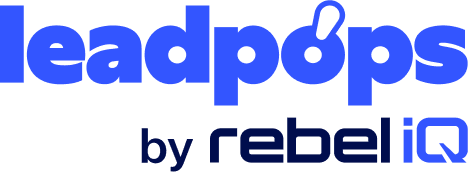How to Build Up to a Call-to-Action that Boosts Conversion Rates

Want to get more results from your call-to-action (CTA)?
It starts with the rest of your content.
The CTA might be an element that you can paste in at the end of a piece of content, sure. But if you don’t properly establish the need for the CTA, you’ll find that your conversion rates aren’t as high as they should be.
We want to fix all that.
When you write newsletters, landing pages, or sales pages—or any piece of written content you want to include a CTA—you have to make sure that the CTA is “built in.”
In other words, the CTA should not only flow freely with the content, but it should make sense within the context of the content.
See Your Potential ROI with leadpops
See what's possible. Fix it fast.
It should make someone who’s been reading through your content think, at the drop of the hat, that they should click forward.
It’s really as simple as that.
But executing a proper CTA? It can sometimes be a bit more complicated than you might imagine.
Here are some strategies you might want to think about using:
Strategy #1: The Loop
In sales copywriting, there’s a concept called “loops.”
Book My FREE
Growth Strategy
Session
See what's possible. Fix it fast.

When you introduce a theme or a new idea, it’s called opening the loop. For example, if your piece of content were to start telling a story in its introduction while waiting to reveal the end, that’s a classic example of an open loop.
If you execute it properly, closing a loop by the end of the piece—such as finishing the story—is a great way to transition into a call to action.
After the resolution of a closed loop, your reader might think “well, what’s next?”
And your CTA is there with the answer.
This is a very natural progression in the reader’s mind. Once a loop is closed, it can often serve as a psychological trigger for that “what’s next?” question.
Strategy #2: The Fix
See Your Potential ROI with leadpops
See what's possible. Fix it fast.
Your CTA is there to fill a purpose.
After all, you wouldn’t link your readers to anything unless you had a specific solution to sell them.
But before you sell them on a solution, you first have to convince them of the strength of the need in the first place.
Someone arriving on your landing page should have a sense that there’s something they need. For example, if they’re looking for a mortgage calculator, they might have the need for a low-interest rate mortgage.
What do they find on your site that could fill that need?
Having a great CTA is a great first step.
Book My FREE
Growth Strategy
Session
See what's possible. Fix it fast.

But the content should also support this CTA. In other words, the content should point towards the CTA—just as the background design of an effective landing page should highlight where the CTA button is.
You can accomplish this by hinting that a CTA is the first step towards solving their problems.
Strategy #3: Telling a Story
Whatever your CTA does, there should be some sense in your content that there’s a story to be told here.
We don’t mean you have to tell a literal story.
You don’t have to write War & Peace to get someone to click on your CTA.
See Your Potential ROI with leadpops
See what's possible. Fix it fast.
But you should have a sense of the natural story taking place here.
What do we mean by that? Simple: think about your ideal client. What kind of problem do they have, and what situation in life might lead them to that problem? And what can you do to fix it?
You’ll notice that this overlaps with the previous strategy: the Fix.
But a story contains a few extra elements that you’ll want to be aware of. For example, the beginning of a story should be about what someone is trying to achieve, but can’t.
For example, in the case of a mortgage company, someone’s story beginning might be the idea of some piece of the American dream. They want a mortgage and they’re after home ownership and the white picket fence.
The second element of a story is the list of obstacles in their way. Problems with credit. Problems with the down payment. Being too afraid to pull the trigger on a loan. Any number of obstacles might qualify here—it really depends on your audience.
Book My FREE
Growth Strategy
Session
See what's possible. Fix it fast.

The last part of the story is usually the resolution. But in this case, the CTA can serve as your resolution.
Strategy #4: Pacing
One of the most important ways to demonstrate to the reader that you understand what they’re going through is a sales technique known as “pacing.”
In other words, you try to match the pace and mindset of your readers. You try to walk them through everything that’s happening.
It can be somewhat difficult to do this through written content or a landing page.
But if you do it effectively, you’ll be able to relate to them on an emotional level.
See Your Potential ROI with leadpops
See what's possible. Fix it fast.
In some cases, there isn’t much time to do any pacing. You might link someone to a simple landing page with an effective CTA at the top. And that’s fine.
However, other cases might be different. In longer content—such as an email newsletter or a sales page—you’ll want to keep in mind what someone might be thinking as they read it.
For example, if you think that you’ve written something that might make a reader skeptical, feel free to say it. You can address their concerns directly.
Even if that’s not what someone was thinking consciously, it can still make for an enticing bit of content. And it will keep the content moving forward.
Strategy #5: Leading Up To It
Finally, you’ll always want your content to work toward a CTA with an effective transition of some sort.
Book My FREE
Growth Strategy
Session
See what's possible. Fix it fast.

For example, you don’t want to spend an entire article talking about one thing, only to suddenly turn around and say “by the way, we have a totally different service to offer you.”
That will not only confuse the reader, but will make them skeptical about clicking forward.
If the CTA is going to feel natural to the reader, it should flow freely as part of the content itself.
That’s especially true for any CTA that you put at the end of a longer content form, such a blog post.
Another way to be sure that you lead up to a CTA properly: make sure that you choose the right CTA.
For example, you wouldn’t want to link someone to a mortgage calculator on your site if they’ve already expressed an interest in your service by clicking on the current landing page.
See Your Potential ROI with leadpops
See what's possible. Fix it fast.
Instead, make sure to keep the person who’s reading the content in mind. What are they looking for? What is their next step? And what can they do today to start solving the problems that brought them to you?
Start answering these questions within the text and you’ll be able to lead up to a CTA the right way. Tell them that they can take the next step—and how.
And if you want a free trial of leadpops to give you the capacity to run an effective CTA in your mortgage company, then you know where the next step will take you, too.



